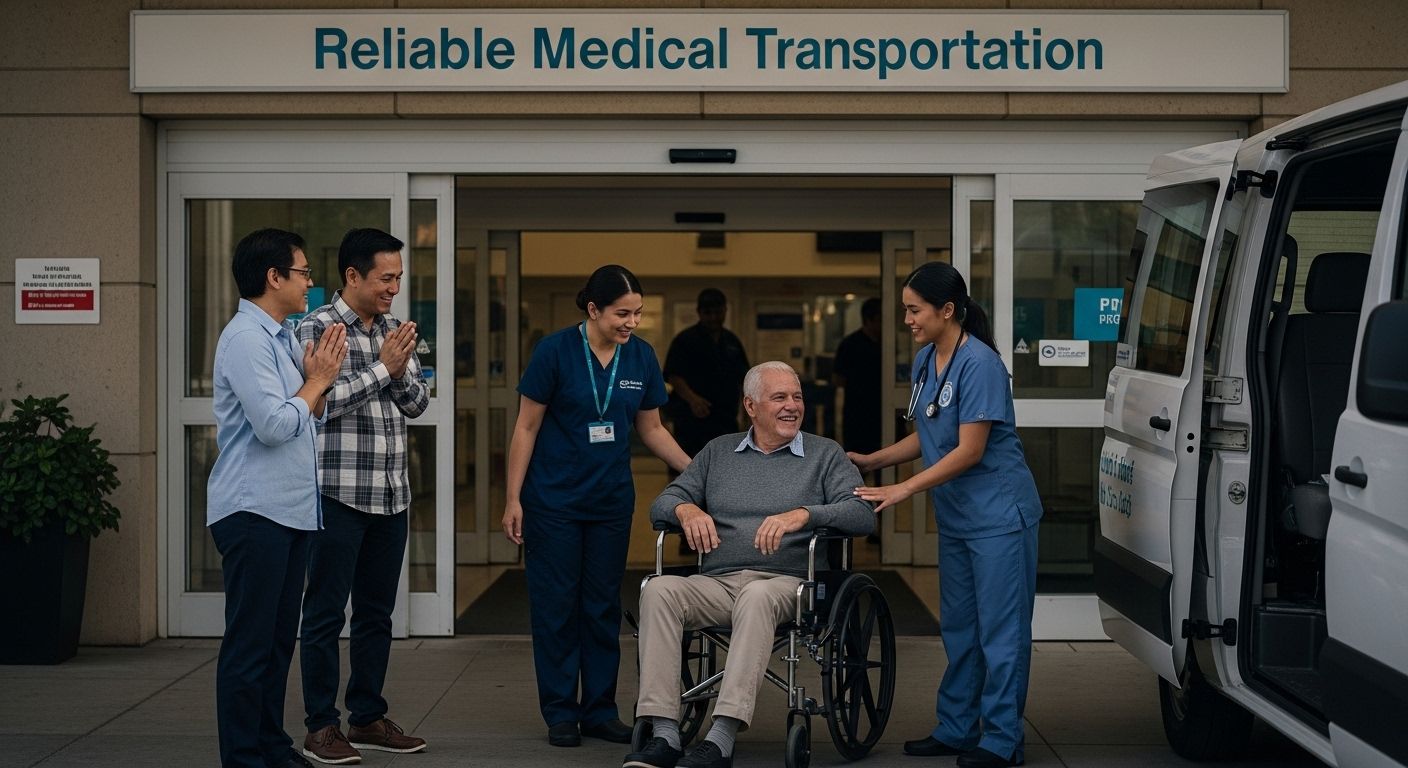Top Healthcare Transportation Software – Expert Comparison 2025

Getting people and equipment where they need to be is never simple in healthcare. Every minute saved in scheduling or in travel means more focus on patients. The right platform can help manage urgent rides, coordinate teams, and make sure resources move smoothly every day. Whether you care about tracking, communication, cost, or care quality, different solutions take very different approaches. Some aim at speed and accuracy, others bring in deep analytics or new ways to stay connected. The real difference comes down to how they fit real-world needs, so finding out what each can actually deliver becomes the big question.
Table of Contents
Vectorcare
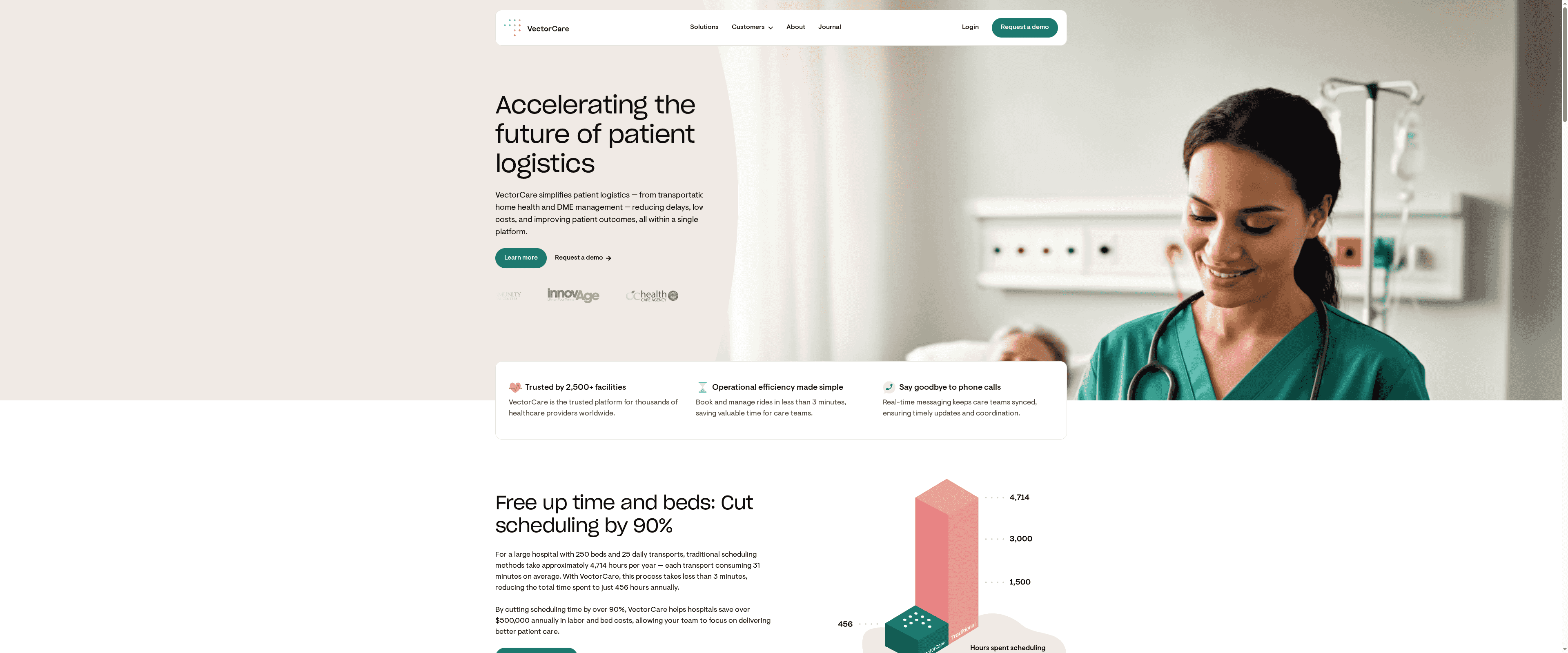
At a Glance
Vectorcare is a purpose-built patient logistics platform that centralizes transportation, home health, and durable medical equipment (DME) delivery into a single workflow. Trusted by over 2,500 facilities worldwide, it speeds scheduling, tightens care-team communication, and drives measurable cost savings. If your organization needs to cut scheduling time dramatically while preserving care coordination, Vectorcare is built for that exact mission.
Core Features
Vectorcare focuses on operational efficiency with practical, high-impact features: book and manage rides in less than 3 minutes; real-time messaging for care team communication; scheduling time reductions of over 90%; and direct connections between providers and transportation, home health, and DME services. The platform also integrates with EMR, CAD, and billing systems so workflows remain seamless across clinical, dispatch, and revenue teams.
Pros
- Massive time savings in scheduling: Vectorcare reduces scheduling time by over 90%, enabling staff to reallocate hours from paperwork to patient-facing tasks.
- Rapid ride booking: The ability to book and manage rides in under three minutes cuts administrative friction and accelerates patient throughput.
- Stronger care-team communication: Real-time messaging keeps clinical and logistics teams aligned, reducing miscommunications that lead to delays.
- Comprehensive logistics coverage: The platform supports transportation, home health, and DME delivery, which simplifies coordination across multiple vendors and services.
- Proven trust and scale: Adopted by thousands of healthcare providers globally, Vectorcare demonstrates reliability and scalability for larger systems and public health operations.
Who It’s For
Vectorcare is designed for healthcare providers and systems that move patients, equipment, and caregivers across settings: hospitals, home health agencies, EMS and fire departments, payers, county and state public health teams, and DME providers. If you manage high volumes of non-emergent and emergent transports or coordinate multiple vendor types, Vectorcare reduces administrative burden while improving patient flow.
Unique Value Proposition
Vectorcare’s edge is its proven, actionable focus on converting scheduling minutes into patient-care time. Rather than a broad toolbox with half-used features, Vectorcare concentrates on rapid ride booking, real-time team messaging, and deep integrations with EMR, CAD, and billing systems—so data flows where it’s needed without manual reconciliation. That laser focus yields measurable outcomes: dramatic reductions in scheduling labor, fewer bed-cost penalties, and tighter handoffs between clinical and logistics teams. Integration effort is an acknowledged design decision: connecting to enterprise systems preserves clinical data integrity and billing accuracy, which is critical for organizations that cannot compromise compliance or revenue capture. In short: Vectorcare trades unnecessary complexity for high-impact orchestration tailored to healthcare operations.
Real World Use Case
A 250-bed hospital used Vectorcare to cut annual scheduling hours from 4,714 to 456—an operational shift that saved over $500,000 in labor and bed costs while improving care coordination during discharge and transfers.
Pricing
Not specified on the website.
Website: https://vectorcare.com
Care Logistics
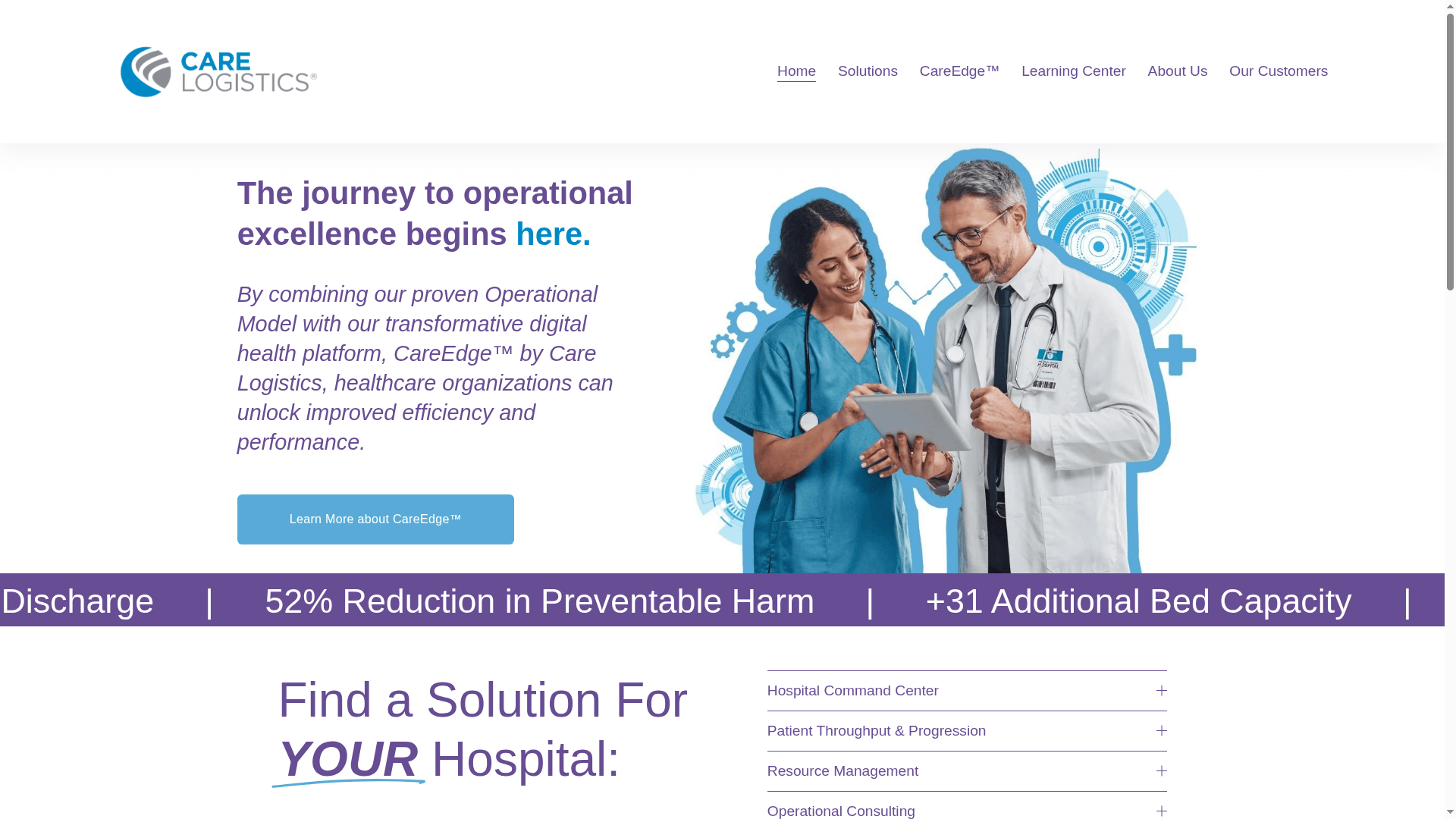
At a Glance
Care Logistics pairs a proven operational model with the careedge™ digital health platform to give hospitals real-time visibility and predictive analytics for operations and capacity management. The company combines technology with strategic consulting to drive measurable improvements in throughput, patient safety, and financial performance. If you need both software and operational expertise, this offering aims to deliver tangible, data-driven results.
Core Features
Care Logistics centers on the careedge™ platform and a hospital command center approach that surfaces operational visibility and coordination. Key capabilities include patient throughput and progression solutions, resource management and optimization tools, and real-time and predictive analytics for hospital operations. The vendor also bundles operational consulting services—strategy deployment, lean improvement analysis, and hands-on change management—to help translate insights into action.
Pros
- Proven operational model improves efficiency and performance: Care Logistics couples software with a tested operational framework that is designed to produce measurable change rather than just dashboards.
- Offers comprehensive digital health tools with real-time and predictive insights: careedge™ provides live operational visibility and forecasting that lets you anticipate bottlenecks before they cascade.
- Delivers measurable financial benefits and capacity improvements: The reported outcomes include concrete capacity and financial gains tied to platform deployment and consulting.
- Supports strategic and tactical operational improvements: The package includes both high-level strategy and ground-level lean analysis to help operations teams implement lasting change.
- Focuses on patient-centered care while improving hospital throughput: The platform is positioned to reduce preventable harm while simultaneously increasing operational efficiency.
Cons
- Specific product customization details and pricing are not provided: The vendor does not list granular customization options or transparent pricing on the website, which makes initial evaluation harder.
- May require significant integration and change management within hospitals: Implementing a command center model and digital platform typically requires workflow changes and cross-department coordination, which can be resource-intensive.
- Complexity of solutions may require staff training and adoption: The combined platform-plus-consulting approach implies a learning curve and sustained commitment to achieve the reported benefits.
Who It’s For
Care Logistics is built for healthcare administrators and hospital leaders who are aiming to optimize operations through an integrated mix of technology and consulting. If you oversee capacity management, patient flow, or quality and safety initiatives—and you’re ready to invest in both platform deployment and organizational change—this solution is targeted at your needs.
Unique Value Proposition
Care Logistics differentiates itself by pairing a digital operations platform with strategic operational consulting. That combination is designed to move hospitals from insights to outcomes—helping teams act on predictions, reallocate resources efficiently, and standardize processes across units.
Real World Use Case
One hospital deployed careedge™ alongside operational consulting and achieved a 52% reduction in preventable harm, added the equivalent capacity of 31 beds, and realized a financial return of $1,664 per discharge—demonstrating that the hybrid technology-plus-consulting approach can produce measurable clinical and fiscal outcomes.
Pricing
Not specified on the website
Website: https://carelogistics.com
RideHealth
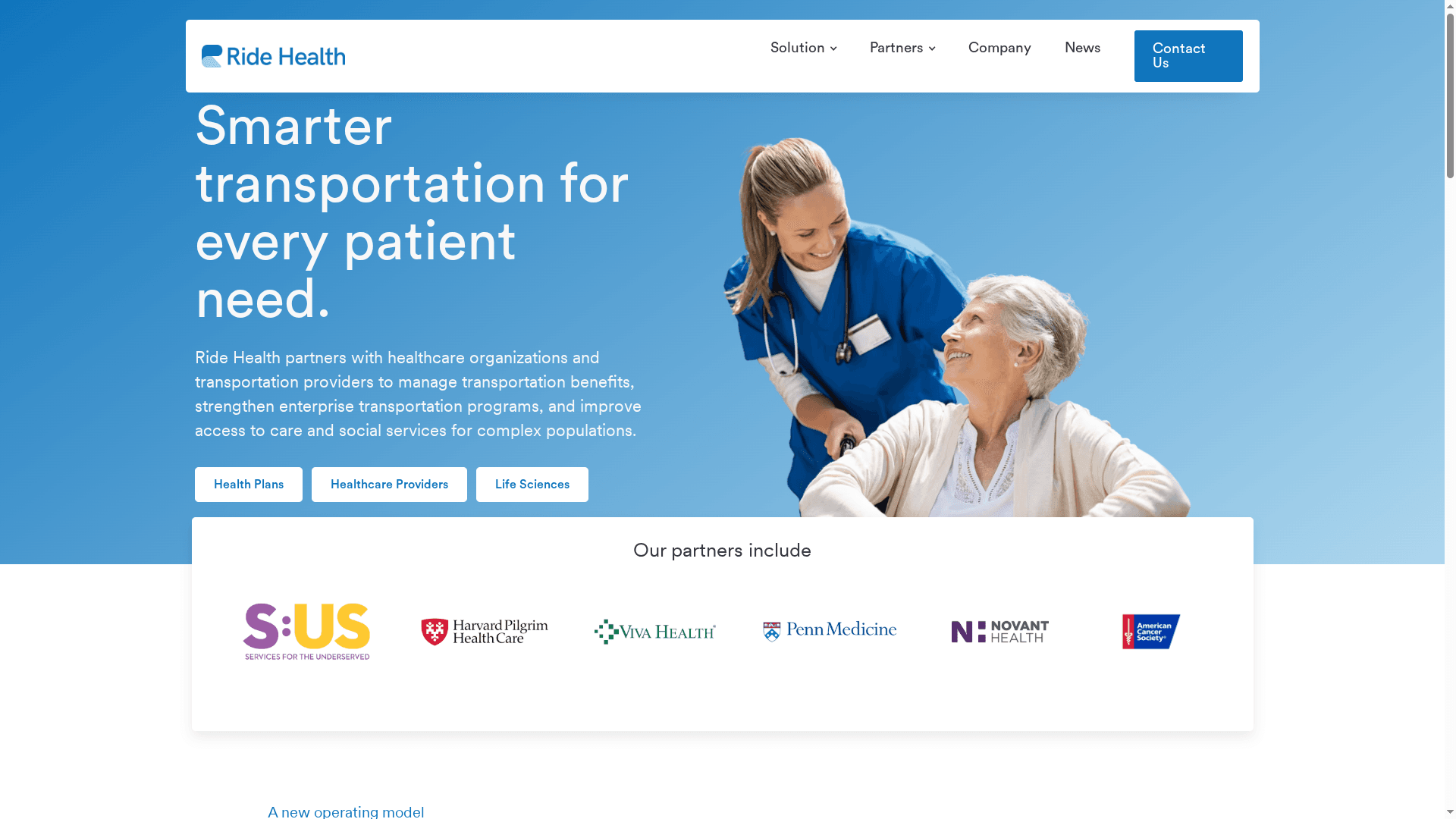
At a Glance
RideHealth provides an integrated, HIPAA-compliant, cloud-based platform that coordinates non-emergency medical transportation end-to-end—from ride request through billing. It focuses on reducing no-shows and improving access to care for complex populations by connecting healthcare organizations, plans, and transportation providers. The platform’s nationwide network and COVID-19 support features make it relevant for organizations managing high-risk or logistically complex patient cohorts.
Core Features
RideHealth centralizes transportation benefits and automates ride coordination with real-time updates throughout the trip lifecycle. The platform supports multiple modes—public transit, rideshare, taxi, and NEMT providers—within a single workflow and includes tools for billing and payment reconciliation. It explicitly supports COVID-19 patient transport and contact tracing, which extends its utility for pandemic response and related care logistics.
Practical. Scalable. Focused.
Pros
- End-to-end ride coordination with real-time visibility: RideHealth provides continuous status updates so care teams and patients have visibility at each stage of the trip. This reduces uncertainty and operational friction.
- Supports a wide range of transportation providers and modes: The platform’s nationwide network brings together public transit, rideshare, taxi, and traditional NEMT services under one management layer.
- Helps improve patient access and reduce no-shows: By managing transportation benefits and automating scheduling, RideHealth targets missed appointments and late arrivals that drive poorer outcomes and higher costs.
- Supports COVID-19 response initiatives: Built-in features for COVID-19 patient transport and tracing make the product useful for organizations still managing pandemic-related logistics.
- Designed for healthcare stakeholders and HIPAA-compliant: The platform’s compliance posture and healthcare focus fit organizational requirements for privacy and regulatory controls.
Cons
- Pricing is not detailed publicly on the website: You cannot find transparent, line-item pricing online, which makes budgeting and procurement conversations harder before outreach.
- May require integration effort for new users: Connecting RideHealth to existing EMR, billing, or scheduling systems could need technical work and project management resources.
- Limited public testimonials or case studies: The site offers few detailed success stories, which makes it harder to assess measured outcomes across diverse deployments.
Who It’s For
RideHealth is aimed at healthcare organizations, health plans, and transportation providers that need an integrated solution for managing non-emergency medical transportation at scale. If you’re responsible for reducing no-shows, managing transportation benefits, or coordinating complex patient populations, RideHealth is built for your workflow.
Unique Value Proposition
RideHealth’s unique value is its healthcare-centric, HIPAA-compliant platform that combines a nationwide multi-modal network with automated coordination and billing in one cloud-based system. That focus on clinical workflows and compliance differentiates it from generic transportation tools.
Real World Use Case
A healthcare provider partners with RideHealth to schedule transportation for high-risk patients, automatically dispatch rides, and track arrival and return times, which reduces appointment no-shows and ensures timely access to care. The provider also leverages the platform’s COVID-19 transport and tracing capabilities for pandemic-era patient logistics.
Pricing
Not specified on the website
Website: https://ridehealth.com
ModivCare
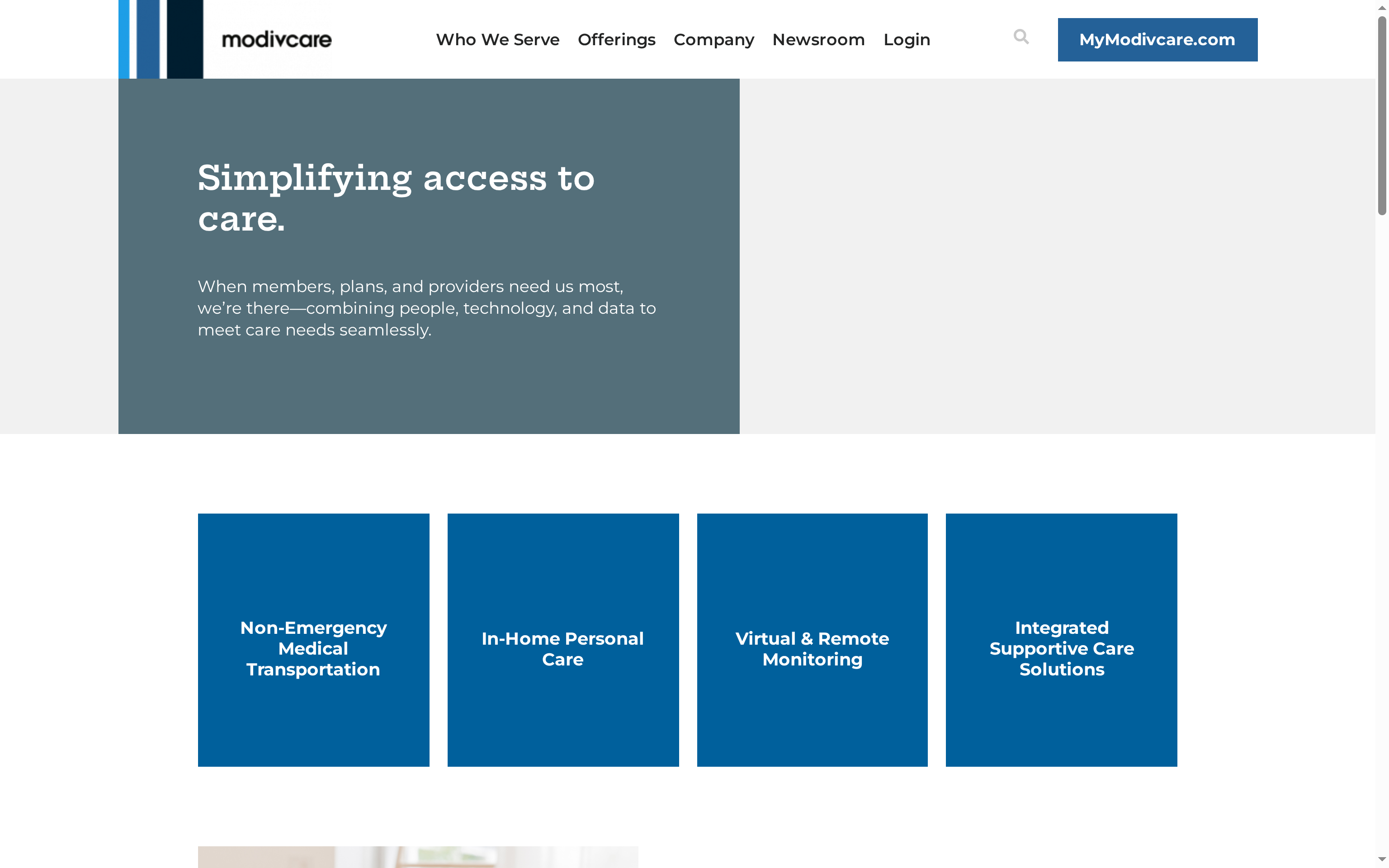
At a Glance
ModivCare combines people, relationships, and technology to close gaps in access to care across complex populations. It emphasizes non-emergency medical transportation (NEMT), in-home supportive services, and remote monitoring with measurable outcomes—like very high trip completion and on-time rates—framed as improvements in utilization and costs. If your priority is proven operational reliability tied to clinical and financial outcomes, ModivCare is worth a close look. If you need transparent pricing or granular regional service details before a procurement decision, expect to ask follow-up questions.
Core Features
ModivCare’s core capabilities center on coordinating supportive care at scale: users can book and manage rides, locate required forms, and explore alternative transportation options; clinicians and care teams can use remote patient monitoring interactions to keep tabs on members; and the platform supports chronic care management and in-home assistance to help patients remain stable outside the hospital. The product positions these elements together to reduce missed appointments, avoid unnecessary emergency visits, and provide integrated touchpoints between members, payers, and providers.
Pros
- Very high operational reliability: ModivCare reports an industry-leading successful trip completion rate of 98% or higher, indicating robust execution across its transportation services.
- Strong punctuality performance: With an on-time rate also cited at 98%+, organizations can expect consistent scheduling and fewer delayed transfers.
- Demonstrated impact on utilization: The company cites reductions in ER utilization in the 40–60% range, suggesting meaningful downstream clinical and cost benefits when services are applied to high-risk populations.
- Substantial cost savings for high-risk members: Reported cost reductions of about 47% for high-risk cohorts point to the platform’s capacity to generate measurable financial value.
- Wide service breadth: Beyond rides, the inclusion of remote monitoring, chronic care management, and in-home assistance creates a multi-modal supportive care offering rather than a single-point solution.
Cons
- Limited public detail on pricing and limits: The information provided is general and does not include explicit service limitations or pricing, which makes budgeting and procurement planning harder.
- Potential regional variability not documented: The data does not specify how service quality or availability varies by geography, leaving questions about consistency across counties and states.
- Lack of user-level testimonials in the provided data: No specific user reviews or testimonials are included here to help validate day-to-day usability or client satisfaction.
Who It’s For
ModivCare is tailored for health plans (including Medicaid and Medicare programs), state agencies, health systems, transportation providers, caregivers, and members who need dependable NEMT and supportive in-home services. It also suits organizations focused on reducing ER use and lowering costs for high-risk populations.
Unique Value Proposition
ModivCare’s differentiator is the combination of high execution metrics (98%+ completion and on-time rates) with clinical and financial impact claims (40–60% ER reduction, ~47% cost savings for high-risk members), delivered across transportation, monitoring, and in-home care — a bundled approach that aims to move patients safely while also improving outcomes and lowering total cost of care.
Real World Use Case
A Medicaid plan partners with ModivCare to manage transportation and in-home support for members with chronic conditions; through coordinated rides, timely in-home visits, and remote monitoring, the plan reports fewer ER visits and better chronic disease management, which translates into cost savings and improved member stability.
Pricing
Not specified on the website
Website: https://modivcare.com
MTM Inc.
At a Glance
MTM Inc. is a long-established provider focused on removing transportation barriers to healthcare, operating since 1994 with more than 29 years of experience and a nationwide footprint across all 50 states and D.C. The company serves over 19 million members annually and offers a mix of non-emergency medical transportation (NEMT), mobile integrated health, and social-determinants-of-health support. Bottom line: MTM is a scale player for organizations that need broad coverage and programmatic experience, though specifics like pricing and advanced scheduling features may require direct inquiry.
Core Features
MTM delivers core NEMT services for Medicaid and Medicare members alongside mobile integrated health that brings care to the home. The platform connects users to community services targeting social determinants of health and supports home and community-based therapies — equine, pet, art, music, and aquatic therapies are explicitly noted. MTM also maintains a provider network and tools for transportation vendors and healthcare partners to coordinate ride scheduling and delivery, and it advertises user-friendly digital tools for members to book and manage rides.
Pros
- Deep, nationwide experience: MTM has operated since 1994 and brings over 29 years of domain knowledge to complex NEMT and community care programs.
- Broad reach and scale: The network spans all 50 states and D.C., serving more than 19 million members annually, which supports statewide and multi-state implementations.
- Diverse transportation solutions: The company offers accessible and varied ride types tailored to different mobility needs, which helps providers meet patient-specific requirements.
- Holistic focus on social needs: MTM explicitly integrates social determinants of health and community services to support aging in place and broader well-being.
- Member-facing digital tools: Users can book and manage rides through online and mobile options, simplifying the member experience.
Cons
- Limited public pricing transparency: The website does not specify pricing details or coverage nuances, which makes procurement and budgeting decisions less straightforward.
- Scheduling feature gaps reported: Users have indicated potential improvements such as multi-stop scheduling and will-call options, which may affect complex appointment workflows.
- Variation by plan or location: Some features and integrations can differ depending on a member’s health plan or geographic area, creating inconsistency for national programs.
Who It’s For
MTM is best suited for Medicaid and Medicare plan sponsors, state agencies, large health systems, and community organizations that require a proven, national NEMT provider with experience coordinating vendor networks and integrating social services. If you need broad geographic coverage and program-level expertise, MTM is a sensible option; if you need transparent, fixed-price software packages, expect to request custom details.
Unique Value Proposition
MTM’s unique value lies in scale plus service breadth: decades of experience, a nationwide provider network, and an explicit commitment to social determinants of health and mobile integrated care. That combination positions MTM to not just move patients, but to connect them with community resources that improve outcomes.
Real World Use Case
A Medicaid member uses the MTM app to schedule an accessible ride to a routine clinic visit; MTM coordinates the trip, supplies appropriate transportation, and connects the member with community-based therapies to support rehabilitation and long-term wellness.
Pricing
Not specified on website; typically covered by Medicaid, Medicare, or specific health plans.
Website: https://mtm-inc.net
Ontime 360
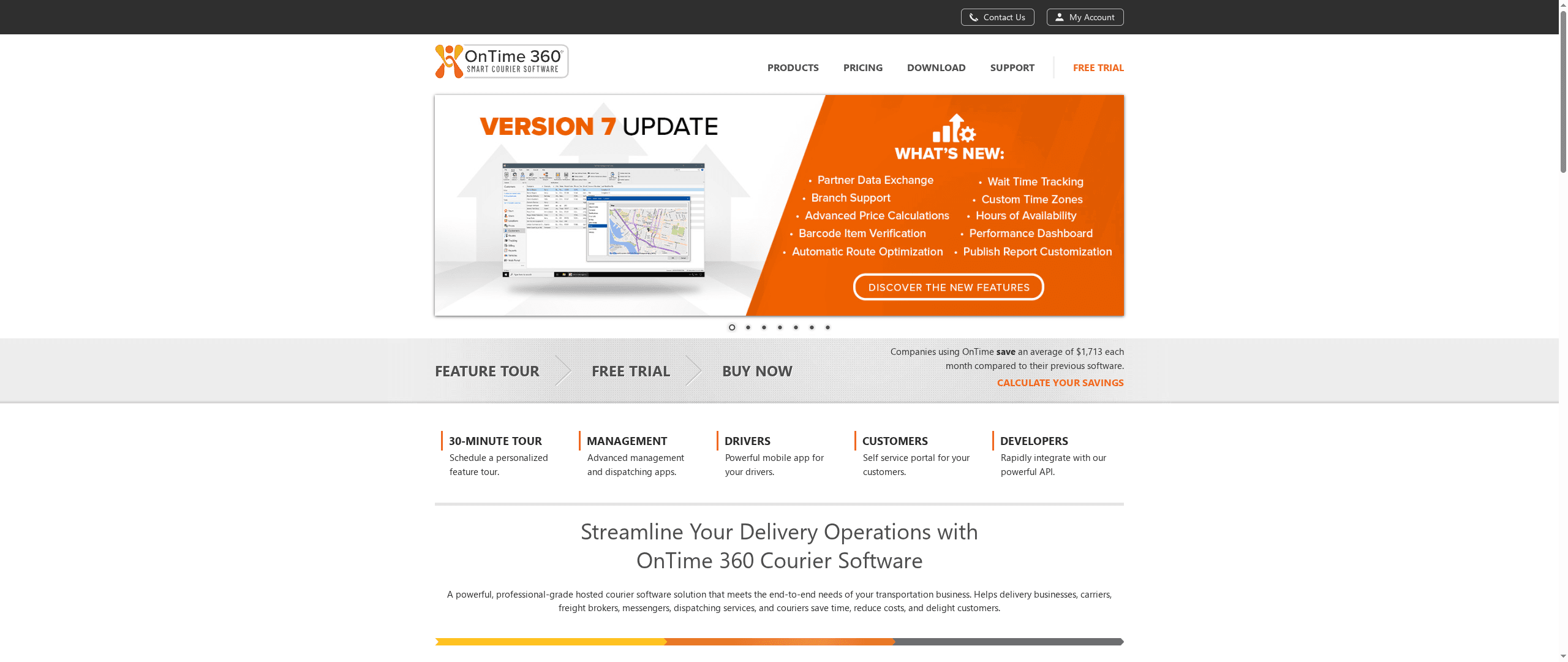
At a Glance
Ontime 360 is a cloud-based courier management platform built to centralize dispatching, route optimization, real-time tracking, proof-of-delivery, and admin workflows. It’s purpose-built for delivery businesses, carriers, messengers, and freight brokers who need an all-in-one operational hub. Bottom line: if you need an accessible, feature-rich system that gets teams moving faster, Ontime 360 delivers — with transparent, entry-level pricing and a 30-day money-back guarantee.
Core Features
Ontime 360 combines a fully cloud-hosted architecture with advanced dispatching and dedicated management apps to coordinate fleet and driver activity. Drivers get a powerful mobile app for on-the-road workflows while customers can use a self-service portal to track deliveries and view proof of delivery. The platform also includes API integration capabilities for rapid system connections — including accounting syncs such as QuickBooks — so you can stitch Ontime 360 into existing back-office systems.
Stop. Read that again. Cloud-first. Mobile-ready. API-connected.
Pros
- Cloud-based and hosted for accessibility and security: Because the platform is cloud-native, teams can access operations from any connected device while vendors manage hosting and security.
- Extensive features at competitive pricing: Ontime 360 bundles dispatch, tracking, route optimization, and proof-of-delivery in a single plan that starts at $99 per month for unlimited users, which is attractive for small and mid-sized operations.
- Broad mobile device and carrier compatibility: The product emphasizes mobile support for drivers, reducing friction when deploying the solution across mixed-device fleets.
- Expert technical support available: The vendor includes technical support to help onboard teams and resolve issues during daily operations.
- 30-day money-back guarantee: You can evaluate the platform risk-free for a month, which lowers the barrier for trial and adoption.
Cons
- Dependence on internet connectivity can impact operations: As a cloud-based solution, reliability hinges on network availability, which may cause interruptions in areas with poor coverage.
- Device compatibility checks may be required before rollout: Although mobile compatibility is broad, organizations will still need to verify drivers’ devices to ensure full functionality.
- Limited public detail on enterprise scalability and custom integrations: The provided information does not fully describe how the platform scales for very large enterprises or supports deep custom integrations beyond standard APIs.
- Pricing beyond the $99 starter tier is not detailed: While the entry price is clear, there’s little public detail about advanced plans or add-on costs.
Who It’s For
Ontime 360 is best suited for delivery and courier businesses of small to mid-sized scale, freight brokers, dispatch services, and carriers that want an affordable, centralized operations platform. If you need rapid deployment, mobile-first driver tools, and a single vendor for dispatching and tracking, this is a practical fit.
Unique Value Proposition
Ontime 360’s value lies in packaging dispatch, optimization, tracking, and proof-of-delivery into a cloud-hosted suite with API bridges to existing systems. For teams prioritizing fast onboarding, lower upfront cost, and mobile driver workflows, the platform reduces complexity and operational overhead.
Real World Use Case
A mid-sized courier company used Ontime 360 to shorten delivery windows by implementing route optimization and improving transparency with customers through real-time tracking and digital proof of delivery — yielding faster turnarounds and fewer missed deliveries.
Pricing
Starting at $99 per month for unlimited users.
Website: https://ontime360.com
Saferide Health
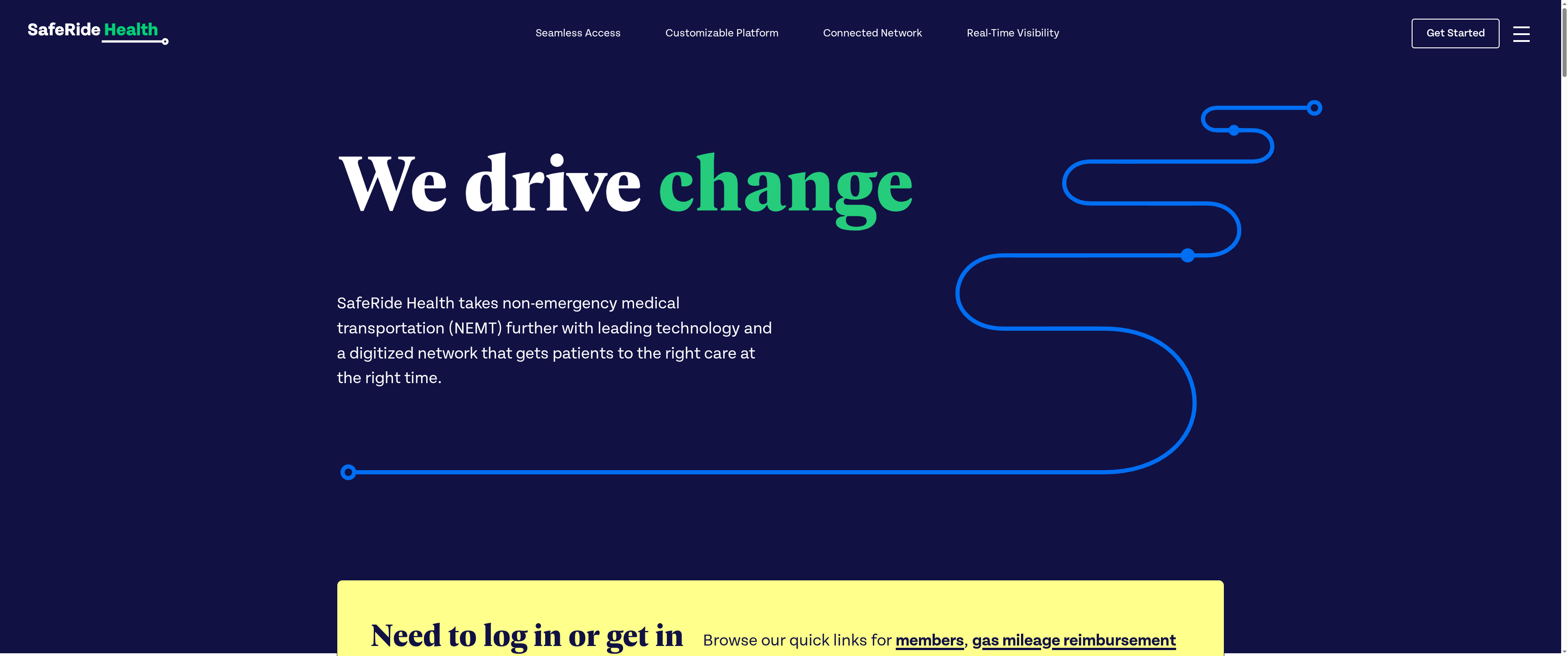
At a Glance
Saferide Health is a tech-first NEMT (non-emergency medical transportation) platform that focuses on getting patients to the right care at the right time via a digitized, connected provider network. It combines real-time visibility, fleet management, and customizable programs to support health plans and providers across urban and rural areas. The platform’s scale is notable: 9 million+ rides annually with a 99.2% fulfillment rate and grievance rates below 0.25%. Bottom line: dependable at scale, but expect a quote-driven procurement process and some onboarding effort.
Core Features
Saferide’s core capabilities center on a digital, connected transportation network with real-time ride visibility and monitoring, customizable transportation solutions for different plan types, and fleet management tools to optimize supply and service delivery in real time. The platform also leverages a wide network of transportation providers across the U.S., allowing health plans to route rides, monitor status, and adjust service rules by member need. In practice this means you can configure program rules for Medicaid, Medicare Advantage, or commercial plans and see live updates on ride progress and fleet utilization.
Quick note: the visibility is strong. Real-time. Concrete.
Pros
- Technology-driven reliability: Saferide uses a digital network approach that supports reliable, trackable transportation workflows for members and administrators.
- Proven scale and throughput: The platform handles more than 9 million rides annually, demonstrating capacity to serve large populations.
- Exceptional fulfillment rate: With a 99.2% fulfillment rate, Saferide shows operational consistency that matters when appointments and clinical outcomes depend on timely transport.
- Low grievance incidence: Grievance rates under 0.25% indicate high member satisfaction and effective issue handling.
- Customizable programs: The ability to tailor transportation solutions by plan and population makes the platform adaptable to varying care models and benefit designs.
Cons
- Pricing transparency is limited: Specific ride prices, subscription costs, and fee structures are not published on the site, requiring you to request a quote to understand total program cost.
- Service complexity may demand onboarding: The platform’s breadth and customization options likely require structured onboarding and training for health plan and provider staff to achieve peak performance.
- No public rate details for quick evaluation: Without open pricing, procurement teams cannot perform rapid benchmarking against internal budgets or RFP responses.
Who It’s For
Saferide Health is built for health plans, care providers, and transportation partners that need a scalable, customizable NEMT solution. If you manage Medicaid or Medicare Advantage populations, run a care coordination program, or operate a transportation network and need real-time dispatching and performance metrics, this platform is a fit. You should be prepared to engage in a brief implementation cycle and accept quote-based contracting.
Unique Value Proposition
Saferide differentiates with a member-centric, tech-first approach that combines scale (millions of rides) and strong operational metrics (99.2% fulfillment, <0.25% grievances). That mix makes it compelling for organizations that prioritize reliability, configurable program rules, and measurable outcomes over off-the-shelf simplicity.
Real World Use Case
A health plan deploys Saferide to coordinate transportation for Medicaid members: rides are scheduled and tracked in real time, appointment attendance rises, no-show rates drop, and member satisfaction improves—illustrating how transport reliability directly supports care access and outcomes.
Pricing
Not specified on the website; quote-based and likely varies by plan scope and services selected.
Website: https://saferidehealth.com
Healthcare Coordination Platforms Comparison
This table provides a comprehensive comparison of various healthcare coordination platforms, focusing on their core features, pros, cons, and pricing as outlined in the article.
| Platform | Core Features | Pros | Cons | Pricing |
|---|---|---|---|---|
| Vectorcare | Centralizes transport, home health, DME; real-time messaging; EMR, CAD, billing integration | Reduces scheduling by 90%; quick ride booking; strong care-team communication | Pricing not specified | Not specified |
| Care Logistics | careedge™ platform; real-time & predictive analytics; operational consulting | Improves efficiency; real-time insights; financial benefits | No detailed customization; potential integration efforts | Not specified |
| RideHealth | End-to-end ride coordination; billing tools; supports COVID-19 transport | Wide transit network; reduces no-shows; supports COVID-19 response | No detailed pricing; potential integration challenges | Not specified |
| ModivCare | High trip completion; in-home services; remote monitoring | High reliability; significant ER reduction; cost savings | No detailed pricing; potential regional variability | Not specified |
| MTM Inc. | NEMT services across the US; integrates community services for social determinants of health | Nationwide reach; diverse solutions; deep experience | No detailed pricing; reported scheduling gaps | Typically covered by Medicaid, Medicare |
| Ontime 360 | Cloud-based dispatch; route optimization; proof-of-delivery | Accessible and secure; competitive pricing; mobile support | Internet dependency; requires device checks | $99/month |
| Saferide Health | Real-time ride visibility; customizable solutions; high fulfillment rate | Reliable network; low grievance rates; adaptable programs | Quote-based pricing; requires onboarding | Quote-based |
Boost Patient Transport Efficiency with VectorCare Today
If the “Top Healthcare Transportation Software – Expert Comparison 2025” article resonated with your challenge to reduce scheduling time and improve care coordination, VectorCare can help you turn those goals into reality. Recognizing the strain caused by fragmented workflows and the need for rapid ride booking, our platform offers a purpose-built solution designed to cut scheduling labor dramatically while strengthening real-time communication across care teams. This focus ensures your organization can deliver timely, coordinated patient transportation and durable medical equipment services without the usual delays and administrative workload.
VectorCare’s integrated platform provides automated scheduling optimization, vendor management, and AI-driven dispatching to eliminate costly bottlenecks. Trusted by healthcare providers worldwide, it delivers measurable cost savings and scalability that aligns perfectly with the demands highlighted in the article. Experience how your team can spend less time on paperwork and more time improving patient outcomes through seamless care logistics.
Ready to transform your patient transportation operations now? Explore how VectorCare’s digital platform supports providers, payers, and emergency services with insightful data and no-code workflows. Visit VectorCare’s landing page to learn more about our solution and how it can address your most pressing logistical challenges.
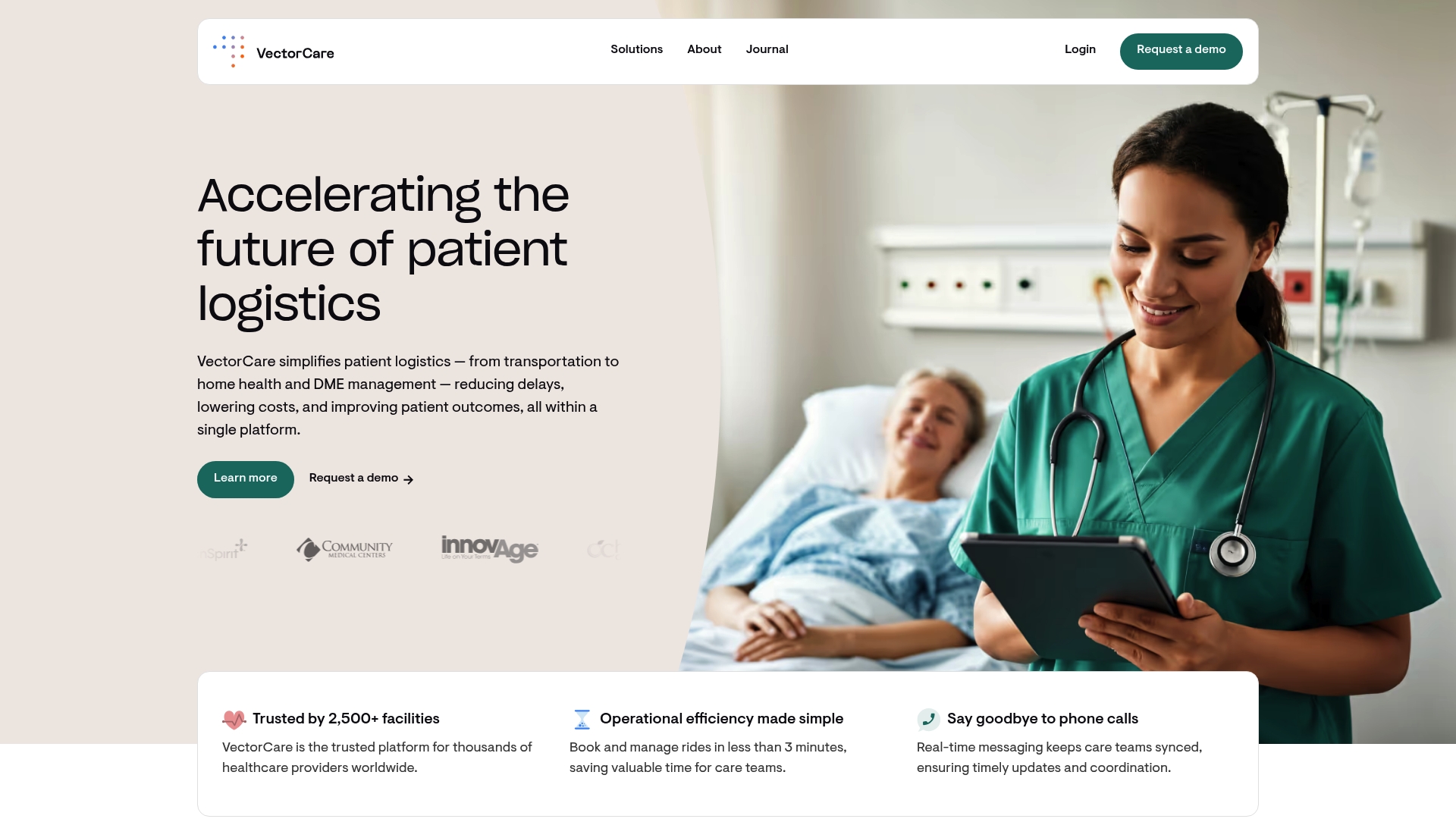
Don’t wait for inefficiencies to affect your patients and staff. Take action today and connect with VectorCare at https://www.vectorcare.com to unlock streamlined healthcare logistics that truly make a difference.
Frequently Asked Questions
What features should I look for in healthcare transportation software?
Look for features that ensure efficient ride scheduling, real-time communication, and integration with existing healthcare systems. Prioritize platforms that enable easy booking management and have capabilities for tracking transportation status to streamline overall operations.
How can healthcare transportation software improve patient care?
Healthcare transportation software can significantly reduce no-show rates and improve access to timely care. By automating ride coordination and managing transportation efficiently, healthcare organizations can increase patient throughput and satisfaction rates by as much as 30%.
What are the primary benefits of using a centralized healthcare transportation platform?
A centralized platform can streamline workflows by consolidating transportation, home health, and equipment delivery. This integration often leads to a reduction in scheduling time by over 90%, allowing staff to focus more on direct patient care instead of administrative tasks.
How do I evaluate ROI for healthcare transportation software?
To evaluate ROI, consider both tangible and intangible benefits such as cost savings from reduced labor hours, improved patient retention, and lower cancellation rates. Track key performance indicators like scheduling efficiency improvements and patient satisfaction scores to quantify your returns.
What steps are involved in implementing healthcare transportation software?
Implementing healthcare transportation software typically involves assessing your specific needs, selecting a suitable platform, setting up integrations with existing systems, and training staff on usage. Aim for full implementation within 30–60 days to minimize disruption and begin realizing benefits quickly.
How can integration capabilities enhance my existing healthcare systems?
Integration capabilities allow for seamless data flow between your healthcare transportation software and existing systems such as EMR and billing platforms, ensuring that all departments are aligned and informed. By enhancing data accuracy across systems, organizations can improve compliance and operational efficiency.


